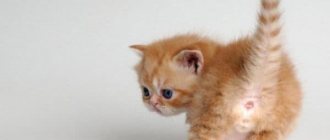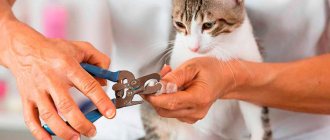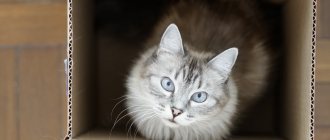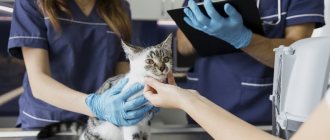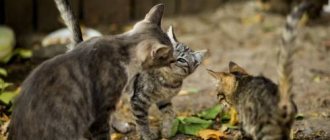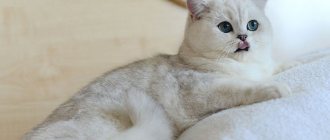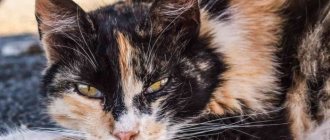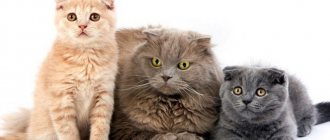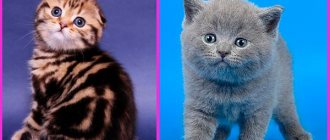What are the colors of Scottish Fold cats - 10 shades of the breed
Popular colors of Scottish cats are lilac, gray, chocolate, golden and blue point or blue. Also often found are pets with dark or light stripes and bicolor pets, painted in 2 colors at once. Depending on the shade of the Scotsman, his character and behavioral characteristics may differ, so when choosing a pet you need to take this nuance into account.
Character and temperament
All varieties of the breed, from black straight cats to the more common gray fold-eared Scottish cats, are characterized by the same character traits.
- They are all kind and affectionate - the Scots are not characterized by aggression and rancor.
- These cats are calm and balanced; natural arousal is recorded only during sexual activity or in the late stages of pregnancy.
- Sociability and loyalty to family members and pets are at the highest end of the measurement scale.
- Good learning ability - Scots are able to remember acquired knowledge for a long time.
- Unpretentiousness in food and living conditions.
Scottish Folds love active games, enjoy general walks and are always ready to keep a person company.
What are the varieties?
Features of solid breeds
Scottish cats have one color. In veterinary medicine, such pets are called solid or solid. Purebred fold kittens are lilac, gray, beige, red, cream or silver. It is also common to see a black cat or male cat, but there should be no impurities, stripes or other patterns on the coat of the Scots.
Black color
This color of the Scottish Fold resembles black marble on gold; the color of such cats is always rich and bright. A pet may have several light hairs, but if there are large patches of beige or brown color, then such a fold-eared cat is not purebred. True purebred animals of this breed are distinguished by black ears and dark undercoat. At the same time, the first ones are tucked towards the head, like all Scots. The exception is straight-eared cats.
White
This type of pet is found with blue eyes, orange and other colors. It is not uncommon to find pets with amber and even copper visual organs. Unlike lilac, gray, chocolate and merle colors, light colored Scottish cats have straight ears. White kittens remain this way until the end of their lives, without changing their color.
Chocolate tones
This color of the Scots looks impressive, but is rare. The following characteristics of pets with a brown tint are distinguished:
- The kittens' coat should be plain and chocolate-colored.
- The Scottish Fold cat with dark brown fur is considered nobler.
- A similar shade is obtained only if the pet’s pedigree includes chocolate, bicolor with a brownish tint, or color point.
Return to contents
Name of kittens with blue color
This breed of Scottish cat can also be called Blue Point. The coat of different pets differs in blue tint. Some are almost gray in color, while others have hairs that are close to blue. To make a Scot like this look good requires every hair to be rich. The kitten comes with white spots or has a silver pattern, which soon disappears. Like Black Scots, Blue Scottish cats often have marbled eye color at 3 months of age.
What makes cinnamon stand out?
Fold-eared pets, which resemble milk chocolate in color, have a similar name. Unlike chocolate Scottish cats, these cats are softer and lighter in color. This breed of cat is notable for its beige or pinkish-brown nose. The ears are almost never pressed to the head, but stick out upward. You may notice striped patterns with a darkish tint.
Lilac or lavender color
A similar color of cats is often observed, and it is obtained if the pet has a lilac color point in the pedigree. This pet color is also known as coffee with milk. Most Scots have dark noses, and the lilac color goes well with this eye shade:
Cream cats
A distinctive feature of this color is the peach-brown shade, thanks to which the breed looks even more elegant. At first glance, the cream type of Scottish Fold cat is similar to the ginger or red Scottish Fold, but if you look closely, the difference is noticeable. The cream breed has light hairs.
A peculiarity of this shade of Scotsman is the presence of a fuzzy pattern on the paws and in the tail area. But it is important that your pet does not have leopard spots.
Red shades
This color is rare. The Scotsman is also known as the red one. The red fold-eared cat is distinguished by defects in the tail area, where the fur is unevenly colored. Pets with such hairs on their foreheads and paws have patterns that indicate their mixed blood. Scottish red cats give birth to kittens with ears straight or pressed to the head.
Scots fawn
This breed is also called faun, but it is found in rare cases. Sometimes the color is mistaken for a lilac Scottish cat, but its difference is the lilac shade. The paws and nose are distinguished by a beige-pinkish color. The Fawn Scots often have amber or marbled eyes, and straight ears, and occasionally you come across straight-eared pets.
Gray or silver
Unlike a black pet or any other solid-colored Scottish cat, this breed has a white undercoat, and the hairs at the tips are colored gray or silver. A special feature of these cats is their green eyes with black edging. The last characteristic is inherent only in silver shaded Scots, and is absent in other colors. The nose is brick-colored, and the mouth and pads are dark-lined.
Primary colors
There are primary coat colors for Scottish cats. Any color of an animal can be classified into one group or another:
- tabby;
- solid (plain);
- chinchilla;
- smoky;
- shaded;
- with a white base;
- colorful (colored);
- tortoiseshells.
These colors are considered the most important for classifying an animal by its color. Each cat of the Scottish breed can be classified into one of the listed groups.
Scottish Straight Color Point
Plain
Another name for this group is solid colors. This type includes monochrome animals with uniform tinting of the coat in one color. Since the British breed was of particular importance when breeding the Scots, the Scottish coat received blue and gray tones, and the color of the iris acquired an amber color. Various variations of genes (dominant, recessive) determined the appearance of different colors of Scots. These can be a variety of shades:
- black or ebony;
- milk chocolate or cinnamon;
- chocolate or brown;
- “deer” – faun;
- red (red);
- soft gray with a pink undertone – lilac;
- pure white.
White Scottish Fold.
A cat's eyes directly depend on the color of its coat. White pets tend to have blue or different colored eyes (heterochromia). Purple and black cats have irises of yellow and copper shades. Amber is typical for individuals of chocolate colors. This type of wool should not be interspersed with any other color. The tone should be rich and uniform along the entire length of the hairs. The presence of marks on the coat means the presence of a defect, which reduces the value of the cat if it takes part in professional felinologist exhibitions.
Cats of this breed, colored pure black, white, red, chocolate, are considered rare. Such kittens will be more expensive. Precious colors - gold and silver - are also considered solid. The task of any breeder is to preserve the purity of the color and its breed type. They are unstable when crossed and are very finicky about adding a new set of genes.
Two-color or bicolor
This term refers to the combination of half the wool is white and the second half can be colored in other colors, for example:
- blue;
- cream;
- red;
- tabby
In the latter case, the pattern must be strictly symmetrical. With this combination, animals can be called cream bicolor or red bicolor.
Blue straight-eared bicolor
Cream bicolor fold
Red bicolor straight
Tabby bicolor fold
Point
The body of the animal has a light basic shade, some areas are painted in darker colors. This is a group of oriental colors (originally found in eastern cat breeds). A similar color is also found in Persian, Fold, Thai and other cat breeds. In turn, color points are divided into subspecies, of which there are 20. There are basic or classic combinations that occur more often than others:
- Seal Point - These cats have a basic white or cream color with dark brown and black spots on the body. In the English version the color is called seal-point.
- Blue point - blue or gray spots on a white-blue background. Other cool shades may occur.
- Chocolate point. The general color of the animal is similar to ivory, and the markings are a brown chocolate shade, but several tones lighter than those of seal points.
- Lilac. Another name for lilac (lilac-point). These cats have spots of brown or gray-pink, lilac, and the body of the animal is light beige.
Interesting read: who are the lop-eared Britons?
Using these colors, breeders created other shades that are now widespread. Such derivatives are:
- cream points – soft cream-colored spots on the cat’s body located on white fur;
- red - red spots on a light body (sometimes pure white);
- Torti – similar to tortoiseshell. The main feature is that it occurs in females. The markings are heterogeneous and can be in the form of a mix of spots of brown, red, cream, and blue. Another feature is that their shade changes with age;
- tabby - the markings are striped, the colors may vary, and the body is predominantly light.
There are also rare points that are considered exotic:
- Cinnamon Point - Markings are cinnamon colored on a beige body. The skin on the pads is light pink;
- faun - light purple markings located on the beige body of the animal.
It is characteristic of all points that the color depends on the animal’s body temperature (in the cold, the colored areas become a little darker and more saturated). Breeders are constantly working with this group to create more interesting marking colors.
Torties or tortoiseshells
Tortoiseshell, also called tortoiseshell, is similar to the coloring of a turtle's shell. Such cats have an interesting pattern on their body, similar to this reptile. This coloration can be unpredictable and may change. This happens after every molt, which occurs twice a year. In this case, the design, pattern, and color of the marks may change. Individuals with this color are almost always sterile and are found only in cats.
Cats with such fur are extremely rare. The color scheme is usually formed by combinations of red, black, and cream colors. Individuals with a color distribution proportion of 1:1:1 look most impressive. There are several features of this color:
- In blue tortoiseshell cats, black can be replaced by blue, red by cream. This creates a bluish-cream combination.
- Purple is replaced by black and red, and cream by purple.
- Chocolate turtles have a black to chocolate substitution.
There are a variety of combinations. The main requirement is a symmetrical, uniform pattern throughout the animal's body.
Smoky
This type is also called smoky or smokey (from the English “smoke” - smoke). Such a cat should have a uniform color without inclusions. The base is silver-white wool. Part of the hair is black, the rest is silver. This type belongs to the silver group. This phenomenon is formed by the dominant gene of this color.
Smokey should not have a pattern, but this can sometimes happen. It can be perceived as a solid (solid) color, but this is wrong. The animal's hair is colored 2/3 of its length and is called shaded. If your pet has thick fur, you need to part the fur to see the color of the base.
Tabby
The animal may have eyeliner on the nose, eyes, a pattern on the chest that resembles a necklace, rings on the tail, paws, spots on the ears or cheeks. There may be a line around the nose. The stripes on the body should not be wide. Marbled species may show a gradual transition to spots on the belly or neck. This pattern stands out against the general background of the pet’s color. There are different tabbies:
- Tiger or mackerel. Such animals may have narrow stripes directed vertically. A pattern resembling a collar appears on the neck. The side stripes rise up the back, forming a saddle-like pattern here.
- Spotted or spotty. Spots of various shapes and sizes have clearly defined boundaries. A line is formed along the entire length of the spine.
- Shaded, whiskey or marble. The pattern consists of spots and stripes that are scattered over the entire surface of the animal. Such animals can have any coat color, the main thing is that they have a pronounced pattern against the general background. It owes its name to its similarity to this textured stone.
Tabby Scottish fold.
Tabbie can also be classified by color:
- Silver. It is the main one, on which a black pattern is applied.
- Silvery blue. The undercoat is white on the sides, face and tail of the animal.
- Reds. Red base with rich red patterns.
- Brown. The wool has a dark copper color, on which a black pattern is drawn.
- Blue. Refers to cream and blue tones. The pattern is expressed against the general background.
- Cream. The base of the wool is light, the pattern contrasts against its background.
- Cameo. White base with red stripes.
This coloration suggests the presence of a zonal pattern on the body. It can be in the form of the letter “M”, which is located on the animal’s forehead.
Paticolor
Characterized by the appearance of white spots of different sizes and shapes. It could even be a white cat with a few spots of a different tone. Two options are considered standard, there are eight in total. The ideal is 1/3 to ½ white. If a cat has more than 90% of its entire surface painted white, the color is called “harlequin”. If an animal has a colored tail, then it is a van.
Scottish Fold Paticolor.
Chinchilla
The basis of this color is tipping. This phenomenon is characterized by the coloring of 1/8 of the hair, most of which is white. A kitten gets this color if both of its parents are colored in the same way. There are three main types of chinchilla:
- golden;
- blue;
- unique.
Silvers may have stripes or shadow marks on their tail. The eyes are green and the nose is beige. The golden chinchilla is characterized by the presence of a reddish tint on the back, sides, and tail.
Ticked
This color is considered rare for this breed; kittens with a similar color are highly valued. The peculiarity lies in the color of the hairs. The hair should have three stripes of different colors. Also, such cats are sometimes called Abyssinian. This creates the image of small specks on the animal’s fur. There may be stripes on the paws and tail.
Interesting read: what to feed the Scots.
Shaded
The coloring extends to the upper third of the hair. The rest of the body is painted white. Such individuals have a light undercoat. The coat is shaded on the sides, back, and head. Golden, silver, and red colors can also be shaded.
Wang
White body except for tail and muzzle. There may be several spots on the animal's body and paws. Their coat is unevenly colored and looks like a tabby.
Harlequin
4/5 of the wool is dyed white. The spots are scattered randomly over the entire surface.
Shaded
ticked
Harlequin
Wang
Cameo
brindle
Other colors of Scottish cats
The black fold cat and other solid shades have no impurities, unlike a breed such as the chinchilla, which comes from British cats. Such fold-eared pets are divided into the following varieties:
The golden ticked color is popular, which is characterized by 2 colors - the undercoat is colored reddish, and the tips of the hairs have a dark shade. Among pets, marbled Scottish kittens belonging to the tabby or tabby type are more common. A special feature of such cats is their pattern, which can be striped, spotted or chaotic spots. The brindle color is popular among the Scots, who have the letter “M” on their forehead. Among tabbies there are golden, cream, blue, and grayish shades.
Tortoiseshell breeds of Scottish cats are characterized by the presence of 3 colors, with the shades distributed in a chaotic manner. One pet has black, red and cream tones; other pets have white, gray and chocolate coats. This coloring is unique to females of the Scottish breed. If you come across tortoiseshell cats, this indicates a genetic failure, as a result of which they are not able to give birth to offspring.
Source
RARE COLORS
Ticked
An extremely rare Scottishfold color. These kittens are very expensive. The peculiarity is the coloring of the fur hairs. Sometimes it is called "Abyssinian". Each hair must have at least three dark stripes. It looks like small specks on the fur. Stripes on the paws and on the tip of the tail are allowed. The letter "M" and a necklace of stripes around the neck. This color is also called “pattern without pattern.” Yellow, dark orange, orange eye color, for silver ones – green.
Chinchilla
Rarely seen, elegant color. Only 1/8 of the tips of the fur are dark colored. Currently, silver, gold and blue-gold colors are known.
All Scottishfold colors are beautiful, sophisticated and amazing in variety. These cats are funny and cute, surprising with their habits. Therefore, the Scottish breed is loved all over the world. And no matter what kitten you choose, it will bring you many pleasant moments in its company.
Solid (solid, plain)
A solid color implies the absence of any slightest admixture of other shades. The surface of the fur is colored evenly on all parts of the body. The Scots once upon a time considered gray or blue to be the most common color. These are the favorites most often found among breeders. But today seals with other colors are also gaining more and more popularity: white, chocolate, black, brown, cream, red and fawn (which literally means the color of a young deer). Sometimes it happens that nature interferes with the uniform color of the fur and leaves a mark of a different color there. Such cats noticeably lose value because they are considered a breed defect.
Point (point)
The more common name for this color is color point. It is characterized by the fact that the main color of the animal turns into a darker color at the tip of the muzzle, tail, ears and paws. This is due to the fact that in the blood of such animals there is a special gene that affects the darkening of the hair in those parts of the body where the temperature is low.
There are several variations of this color, which are shown in the table below, there may be others:
| Color name, photo | Main color | Additional color |
| Seal Point | Light beige | Brown |
| Lilac Point | Pale blue | Dark blue |
| Chalklit Point | White | Brown |
| Cream-point Cream-blue-point | Pale cream | Cream |
| Red point | Pale cream | Ginger |
| Tabby (lynx) point | Any | Stripes to match the main color |
| Torty point | Tortoiseshell | Red or cream spots on the base coat color |
Torti (turtle)
It should be noted right away that you can only buy a turtle girl. In males, this color is not provided by genetics. But if you do come across a cat like this, then this is a big exception, which, however, does not increase its cost, but, on the contrary, reduces it.
Tortoiseshell color is considered to be fur on which spots of different colors (black, chocolate, blue, lilac) alternate with red or cream marks. For breeders, a particularly important indicator is the intensity of pigment expression and uniformity of location.
Smoky (smoky, smoky)
The main condition for this color is that the hairs at the base of the body must have a silver-white tint. Those. the silvery-white hair turns into another color, such as black or blue. This phenomenon is called typing and occurs as a result of a dominant silver gene. The smoke can be different, for example, chocolate.
There are often cats with additional patterns on their fur, but according to color rules this should not be the case.
Don't confuse this color with a solid color! If you're not sure, part your cat's fur and see what color is at the base of his fur.
Origin story
The ancestor of Scottish cats is considered to be a cat named Susie, who was born in 1961 and was a carrier of the mutation gene (FdFd), which is why her ears were folded. It was with this cat that work began on the Scottish Fold breed. Breeders sought to consolidate fold ears in their descendants, and to give the breed a pretty appearance, crossbreeding was carried out with other breeds: Persian, Burmese, American Shorthair and British. As a result, the breed developed a rounded head, large round eyes, and lop ears.
Breeders have noticed that if Scottish Folds are crossed with each other, this leads to congenital malformations of kittens (problems with the spine). Then it was decided to cross Folds only with Straights, in order to avoid the harmful effects of the mutation gene for folded ears.
In a litter of Scottish cats, both fold-eared and straight-eared kittens were born, approximately equally, and mainly fold-eared kittens were developed and exhibited. In the 21st century, they decided to eliminate this injustice and recognized the straight-eared Scots as a separate breed with the right to an exhibition career. Straight-eared Scots are no different from folds, with the exception of the shape of the ears and the presence of mutation genes.
Tabby (tabby)
Such cats have stripes of an unusual shape and a different color than the main color. The most common marks are on the forehead, for example, in the shape of the letter M, light spots on the back of the ears, a necklace on the chest, rings on the paws and tail, curls on the cheeks, eyes outlined as if with shadows.
Breeders distinguish several variants of tabby. According to the type of pattern, they are marbled (shaded), tiger (mackerel) and spotted (spotted).
There is a complex classification of Scots tabby dogs based on combined colors and shades. They are presented in the table below:
| Name | Main color | Pattern color |
| Silver | Silver | Black |
| Silver blue | Light blue, white undercoat | Mantle on muzzle, tail and sides |
| Red | Light red | Bright red |
| Brown | Cream blue | Bright blue |
| Cream | Pale cream | Beige or dark cream |
| Cameo |
Scottish Straight Standard
The Scottish Straight cat became an independent breed from the Scottish Fold breed, and was officially recognized by the International Cat Fancier Association (CFA) in 2004.
Scottish cats come in long-haired and short-haired varieties, and come in a variety of colors, patterns, and shades. It can be plain, ticked, patterned or spotted.
The main difference between Scots and British cats is the clearly defined shape of the head, proportional legs, and pointed ears. The British are naturally more massive, with characteristic cheeks on the face, rounded ears and the tip of the tail.
- Body: medium size, proportional, well-developed muscles. The body shape is round. Massive body size is considered a disadvantage. The weight of the animal is within 6 kg. Cats are bigger than cats.
- Head: round, voluminous. The chin is pronounced. Cheeks are full. The nose is straight, wide, short. There is no stop. The head smoothly transitions into a wide and short neck.
- Ears: straight, widely spaced, full size. The shape and fit of the ears favorably highlight the roundness of the head.
Important! If a Scottish Straight has small ears, then it is quite possible that it is a Scottish Fold with straightened ears. This fact is very important if you are adopting a kitten for further development of the breed.
Shedded (shaded)
With this type of color, two-thirds of the hair starting from the base is white, and the remaining part can be red, silver or gold. On the chin, belly and lower surface of the tail the color is light. The shaded color does not allow spots or stripes except those located on the forehead or paws.
Representatives of the Scottish breed with a similar color have white coat color as the main color, and the tail and muzzle are decorated with a different color or a combination of both (torti). There may also be spots on the body and paws.
White based colors
These colors of Scottish breeds are:
- Bicolor. Two-color ones, in turn, are presented with the addition of the following colors to white: blue, black, cream, red. The muzzle, abdomen, limbs and thighs remain entirely light. The eyes are the color of gold or sky. Such tartans can have eyes of different colors.
- Wang. Almost all the fur is white, only the tail and a couple of markings on the head are colored.
- Harlequin. The edge is mostly white, only a fifth of the surface is colored.
- Ticking. All fur with distinct ticking. The eyes are all shades of gold; those with a silver color are greenish.
The rarest colors of Scottish cats
Several years ago, the highest price was set for kittens of unusual silver and gold shades. But in the modern cat market there are more and more of them. Today, ticked Scots and golden chinchillas are considered the most expensive.
Scottish straight golden chinchilla
Interesting! The most common iris color among Scots is gold. However, there are some exceptions. Usually the eye color matches the coat. Blue or multi-colored eyes are quite rare, these animals can be white, bicolor or tortie. Orange iris is a very beautiful, but the rarest eye color in this breed.
Genetics of Scottish cat colors
In cats of this breed, 2 genes predominate, which are responsible for the red and black color. One of them acts as dominant, and the other as recessive (i.e., the one that is suppressed). There is also a 3 diluent gene, which is responsible for the saturation of the pigment. These genes are combined and as a result we get a variety of colors: from the well-known blue to the cheerful-looking harlequin.
By the way, while the kitten is still small (several weeks), it is impossible to say exactly what its color will be. The final coloring is formed when, after a child's molt, the coat is replaced by an adult coat. Usually the color is ready by six months, although it may change slightly for another 1.5 years.
And a little about secrets.
The story of one of our readers, Irina Volodina:
I was especially distressed by my eyes, which were surrounded by large wrinkles, plus dark circles and puffiness. How to completely remove wrinkles and bags under the eyes? How to deal with swelling and redness? But nothing ages or rejuvenates a person more than his eyes.
But how to rejuvenate them? Plastic surgery? I found out - no less than 5 thousand dollars. Hardware procedures - photorejuvenation, gas-liquid peeling, radio lifting, laser facelift? A little more affordable - the course costs 1.5-2 thousand dollars. And when will you find time for all this? And it's still expensive. Especially now. Therefore, I chose a different method for myself.
Cats from Scotland are famous for their charming appearance and rich colors. Here, all possible colors of fold-eared and straight-eared Scottish beauties will be examined in detail, and characteristics will be given according to the breed standard.
All possible types of appearance of these cats are collected in a number of groups:
- tabby color;
- solid color;
- chinchilla (see British chinchilla cat);
- smoky;
- shaded;
- colors with a white base;
- colorful colors;
- tortoiseshell.
Scottish cat color charts
When purchasing a Scottish kitten with a passport from a breeder, most likely you will see markings of numbers and letters there. This is an international code used in the classification accepted among breeders. The Scottish breed includes four cats: fold-eared (Scottish Fold), straight-eared (Scottish Straight), long-haired fold-eared (Highland Fold), straight-eared long-haired (Highland Straight).
This is what the color code looks like: XXX.xx.NN.NN.NN.(NN) , where:
XXX . Abbreviated name of the breed in three capital letters: SFS - Scottish Fold, SFS 71* - Scottish Straight, SFL - Highland Fold, SFL 71* - Highland Straight.
xx . Lowercase letters indicating the main coat color (up to two):
Russian nameabluebluebchocolate, brown, chestnutchocolate, brown, Havana, champagneclilac, lavenderlilac, lavender, platinumdred, flameredecreamcreamfluortoiseshell, patch tortoiseshellgblue-cream, blue-tortieblue cream, blue tortoisehchocolate-tortiechocolate tortoisejlilac-tortielilac turtle ovynblack, ebony, seal, sable, ruddyblack, ebony, seals, sable, wildosorrel, cinnamon, honeysorrel, cinnamon, honeypbeige fawnyellow-brown, beigeqsorrel tortiered-brown tortoiseshellrbeige fawn tortiebeige tortoiseshellsilver, smokesilver, smokywwhitewhiteygoldengoldenzunregisteredunregisteredNN.NN.NN.(NN) - values of pairs of digits (up to 3 main and 1 auxiliary):
- Numbers from 1 to 35, which decipher the color features (harlequin, van, smoke, etc.):
| Letter (designation) | English name | Russian name |
| 01 | van | van |
| 02 | harlequin | harlequin |
| 03 | bicolour | two-color, bicolor |
| 04 | mitted/white point | with white markings (for color points) |
| 09 | little white spots | white spotting (1-2 cm) |
| 11 | shaded | shaded (1/4 of the top part of the hair is darkened) |
| 12 | tipped, shell | veiled (1/8 of the top part of the hair is darkened) |
| 21 | tabby, agouti | striping, agouti factor |
| 22 | blotched, marble | marble |
| 23 | mackerel, tiger | mackerel, tiger |
| 24 | spotted | spotted |
| 25 | ticked | ticked or Abyssinian |
| 31 | burmese | Burmese |
| 32 | tonkinese | Tonkinese |
| 33 | himalayan or siam | Himalayan, Siamese, point |
| 34 | Singapore | Singaporean |
| 35 | abyssinian | Abyssinian |
- A pair of numbers from 51 to 54 indicating the length of the tail:
| Letter (designation) | English name | Russian name |
| 51 | rumpy | taillessness |
| 52 | rumpy riser | remainder of the tail – 1-2 vertebrae |
| 53 | stumpy | bob – 7-13 cm. curled tail |
| 54 | longy | long/normal tail |
- A pair of numbers from 61 to 67 indicating eye color:
| Letter (designation) | English name | Russian name |
| 61 | blue | blue |
| 62 | yellow, golden | yellow, orange, golden |
| 63 | oddeyed | disagreement |
| 64 | green | green |
| 65 | burmese | Burmese cat eye color |
| 66 | onkinese | Tonkinese cat eye color |
| 67 | himalayan or siam | eye color of Himalayan and Siamese cats |
- A pair of numbers 71 (straight) or 73 (dropping), indicating the shape of the ears.
How coat color affects the character of a Scotsman
When purchasing a pet, you should not chase fashion; it is better to trust your preferences and tastes. The main thing is that the cat turns out to be “yours” in temperament and character. By the way, some cat owners are sure that the color of the fur affects the behavior of the animal and leaves an imprint on its character.
White and light colored
You want to cuddle these babies endlessly. But they, as a rule, do not like increased attention to themselves. Although they are very loyal to the owner, they are extremely wary and wary of other people. Among some peoples there is a belief that a white cat brings good luck. Whether this is true or not is not known for certain. But the white color can cause a lot of problems for the cats themselves, since 5% of all snow-white cats are born completely deaf. Previously, it was believed that deafness was the fate of absolutely all white-furred tails, but later scientists proved that this is not so. But when buying such a kitten, you should still be more careful.
Black
Despite all the existing prejudices and myths regarding black cats, in practice they are one of the friendliest towards people. They like to stay close to their owner all their free time and always keep him in sight. Charcoal cats are wise, quick-witted, and keenly aware of a person’s mood.
Redheads
Such animals are a ray of sunshine in your home. It is believed that a ginger cat in the home is the key to an indispensable increase in well-being. Those with fiery fur are very playful, willful, cheerful and curious creatures. The golden shades of fur that are fashionable today are characteristic of more formidable animals, whose disposition can hardly be called friendly. And golden Siamese cats are generally considered the worst tailed cats.
Blue and silver
Silver and blue fluffies are real aristocrats. Calm, balanced, noble. They love their owner devotedly, although they are not always ready to demonstrate this publicly. It is believed that these four-legged pets are able to calm and relieve stress in humans. In addition, cats of this color are absolutely not vindictive.
Two-color
Such cats are most in demand among buyers. In addition to their interesting color, they have an easy-going disposition, are friendly, and kind even towards children. Bicolor cats love their owners very much and get along well with other pets.
Care and maintenance
Scottish Folds are rightfully considered one of the cleanest cats. They do not require complex care like Persians. Representatives of this breed take care of their fur themselves. They very quickly get used to going to the tray and, if there is a scratching post, they will never damage the furniture. Representatives of this breed will not cause trouble to their owners in the form of scattered things or torn curtains. They will not climb on shelves and throw off everything that comes under their paw.
If Fold stays alone at home for a long time, you need to come up with activities for him, choosing toys for your pet. These can be soft imitations of mice or rubber toys with springs.
Cats of this breed need to create their own place in the house. This could be a cozy bed in the form of a basket, or a house with tiers of platforms on which the cat can stretch.
Grooming
In Folds, the coat can be short (Scottish Fold) or semi-long (Highland Fold), while always remaining thick and dense. Short hair is easier to care for. The cat should be brushed once a week with a special mitten or brush that uses natural bristles. Semi-long wool is combed out with a special metal comb, the teeth of which are coated with Teflon.
The cat needs to be washed once a month. If the animal is preparing for an exhibition, then this will need to be done more often. You need to use special shampoos, selecting them for a specific coat color.
Claw care
The claws of domestic cats need to be trimmed, being careful not to touch the living part of the claw. This should be done once or twice a month.
Ear and eye care
You should clean your ears when plaque appears in them. For this, cotton swabs and a special liquid are used, which should be purchased at a pet store. If the kittens' eyes are running, they are instilled with special drops.


